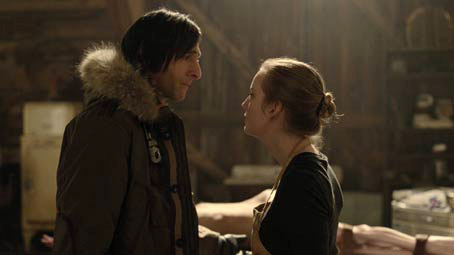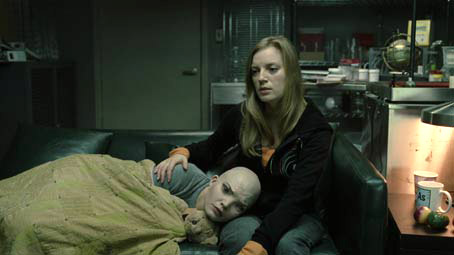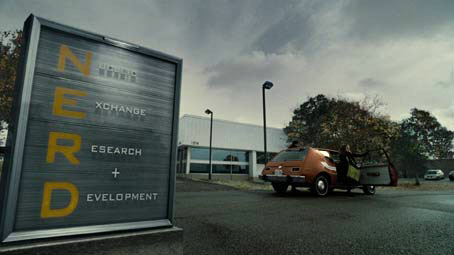Editor's note: The posting of this review was delayed by the (very) late arrival of the Blu-ray disc due to the recent inclement weather, hence the pre-Christmas references in the title and the summary.
I'm no scientist. I did poorly at many subjects at school and the various sciences were prime examples of this. I don't have a brain orderly or precise enough to contain the intricacies of such a subject. Not that I have no interest in this fundamental world of information. So for me, as no doubt for many like me, science-fiction has been my entry into these foreboding realms. The accessibility of fiction works wonders as a platform for the education of fact, and the amount I've learnt through its various media is gargantuan, no more so than with science. So it is here where I begin to talk about the overriding concept of Splice – genetic experimentation – a realm I have not previously delved into, save the surface news stories, most memorably the mouse with the human ear on its back (mentioned by the director of Splice in an interview on this very DVD). But this is an ever more relevant and evolving science, and at the time of writing about a film that is now science fiction, its plot is becoming increasingly plausible as science fact. That alone gives Splice an edge over recent generic sci-fi.
Splice is itself a hybrid – it amalgamates sci-fi and horror with the unlikeliest relationship drama, creating an unusual species of movie. Director and co-writer Vincenzo Natali wrote the first draft of the film twelve years ago, and it has taken this long to finally bring his vision to the screen. Its dark plot and bold tackling of its subject matter hints at why the project was so difficult to bring to fruition. Also Natali has a modest, although impressive back catalogue, with Cube his most successful of the three feature films he helmed before Splice. He clearly has a talent for creative and intelligent sci-fi, and Splice is probably the most accomplished example to date.

Two young prodigious geneticists share both their personal and work lives, spearheading the creation of chimera, creatures comprised of two or more groups of animal cell. Their latest creations are two such beings of fleshy blancmange appearance, crude but sophisticated enough to produce healing potential within its genetic make-up. The couple, Clive (Adrien Brody) and Elsa (Sarah Polley), have developed these hybrids for a corporation wishing to use them to develop medicines. But Clive and Elsa have uncovered something far more revelatory, as they deem it possible to create a human/animal chimera, thus opening up a whole new world of possibilities. When they tell their boss this exciting news she shuns the idea in favour of their planned and safer course. The couple are outraged, and with the exuberant petulance of youthful geniuses in love, they resolve to take on the challenge regardless of their superior's wishes. What ensues is the creation of a chimera that Clive is wary of, but Elsa's maternal instincts kick in and to Clive's trepidation they continue to aid its development. Hiding their illegal project from their employers becomes increasingly difficult until Clive's brother (Brandon McGibbon) discovers what's going on, and the humourless and unwitting suit employed to keep them in line (David Hewlett) plans to close down the area they have been keeping the subject. By now Elsa has developed a strong motherly attachment to the ever growing creature, naming her Dren when she deciphers Elsa's N.E.R.D t-shirt. In order to keep her alive and hidden, the couple take her to an abandoned farm owned by Elsa's diseased and abusive mother and hole her up in a big barn. As Dren ages at a fast rate, Clive and Elsa continue to struggle with their personal demons regarding Dren to a point that they question both their morality and their roles in her life. The line between right and wrong worryingly fades and a mistake made earlier regarding their original hybrid guinea pigs repeats itself, resulting in a shocking violation and a horrific and thought-provoking conclusion.
The main function of science fiction is to examine ourselves as humans, generally with cautionary tales of what could be, and Natali does not deviate from this basic template. What makes this soar above its generic familiars is the depth and richness of its content and aesthetic – as with all good sci-fi movies. Natali, along with his co-writers Doug Taylor and Antoinette Terry Bryant, weave in a strong relationship theme within the modern Frankenstein morality tale, giving the film a solid emotional foundation. More ambitious still is the way in which this plot thread pans out, in itself a daring topic more synonymous with European or Asian cinema. Taking the audience to such recesses of the human psyche in the case of both protagonists adds another dimension to a story that by itself could have seemed a little stale.

Visually the film comes upon you like a fever. Its bruised and anaemic tones washed with a vapid aqua-marine add to the clinical aesthetic. Under strip lighting these blanket illuminations degrade any richness of colour from the frame. Often claustrophobic in their labs and offices, natural light is rarely seen and when outside the night generally pervades its own darkness. Shots seldom move in the first two thirds of the film, visually reflecting the slow burning narrative pace, and there is an order to compositions that reinforce the orderly nature of the laboratory setting with symmetry in mind. When we move into the country this is destabilised, highlighting their new detachment and vulnerability the carefully written plot has laid down in the relocation. We are now on home ground, broken away from the scientific order of the lab to a place less certain, a place Clive does not understand and Elsa did not wish to revisit. A place where the cracks start to show.
Moving back to mise en scène, Dren herself is a painstaking process of creation. In a film that did not boast a Hollywood budget, bringing Dren to life could have been Splice's downfall, but, although the CG could never quite stand up to multi-million dollar blockbuster treatment, the result is believable enough to forget you're watching a pile of effects. As she ages the effects lessen anyway, and the performance of Delphine Chaneac shines through wonderfully as the post-pubescent Dren. It is at this point her character must really engage with her makers on a personal level, which I will discuss later in reference to performance. All elements of special effect are carefully executed (as the extra features detail), from the animatronics and models used together with the computer effects to the gore gleefully splashed out at sparing moments. One set piece in particular involving Ginger and Fred, the couple's prototype hybrids, relishes in the chance of a bit of blood and guts. Even here though, where the crew can have fun with the gore, the scene is crucial to the plot development and eventual outcome of the film.
The richness of theme in the plot's progression and the visual style are backed up by a haunting yet mostly understated score by composer Cyrille Aufort. Some parts are a bit overly traditional in their orchestration for my taste – my personal favourite use of sound is in the music Clive puts on throughout the film, carrying a narrative punctuation of their own and varying in style and emotional emphasis. The juxtaposition of the natural and the synthetic or man-made organism is highlighted with electronic music interchanging with classical and jazz.

Splice is so well made that everything works in harmony with its counterparts, binding together to create a solid movie with a very credible script at its heart. The morality preaching is contained by other more interestingly unusual questions, while the corporate agenda versus human passion is evident throughout as Clive and Elsa continue to butt heads with bosses and ignore orders. But through their humanity they corrupt themselves in trying to handle their creation – this is a twisted dysfunctional family where the roles of each member become confused, with the element of the scientific and man-made assembly of Dren exacerbating an already complex relationship. In the last act of the film, the deviance of science is mirrored with the deviance of sex, creating a moral point of no return that escalates to a marriage of both in a horrifically predictable climax.
The three central performances are all excellent. The interaction between the couple and Dren in the third act of the film is especially engaging, as shocking conduct of Clive and Elsa could easily alienate the audience in less competent hands. As a big fan of his work anyway, I expected as much from Brody, but the female leads of Polley, who plays Elsa with a real depth of emotion, and the later Dren incarnation Chaneac, were unknown to me (yet research has led me to realise I have seen Polley in a few minor roles including 1999's Go and the remake of Dawn of the Dead). So it was a pleasant introduction to these lesser known actors to see them in such demanding roles. I expect on the back of this film both will go on to enjoy higher profile careers. The peripheral roles are all played to a high standard, well supporting the focal characters, especially Simona Maicanescu, who plays the sinister company executive with a feline detachment, almost a sedate bond-villain quality adds to her presence, appearing in only a couple of scenes but managing to remain uncomfortably memorable.
In short, Splice is the best and rarely seen type of science fiction – intelligent, thought-provoking and creative. Natali comes out from fellow Canadian visionary and inspiration David Cronenberg's shadow with this film, managing to create something evoking Cronenberg's earlier directorial days but with a very 21st century emphasis. With his mind set firmly outside the box and Splice throwing a spotlight on his talents, what next can we expect from this auteur in the making? Fingers crossed it can equal or even eclipse this endeavour.
Splice is a low budget movie with a consistently dark look and if you're looking to be blown away by its Blu-ray beauty you're likely to be disappointed. There is a clearly visible increase in picture detail over the DVD, most evident in the lab footage where the lighting and the busy mise-en-scène give the transfer plenty to work with, but elsewhere it's more about subtleties of image richness that give the BD disc the edge. The colour palette leans towards earthy tones or the blue-grey hues in the lab environment, with primes taking a back seat, and there's a gloom that hangs over even the daylight exteriors, which while appropriate to the film and effective for the mood does ensure that the picture rarely pops in the manner of more mainstream releases. The depth of field is also very shallow in places, giving the (false) impression that some shots are on the soft side. Grain is also visible throughout, but in a way that feels right for the tone.

You can choose between 96 kbps LCPM stereo 2.0 or DTS-HD Master Audio 5.1. Subtlety is once again the watchword here. Clarity and separation are clear on both tracks and just occasionally the effects are sharp and punchy enough – the sequence where Elsa gets her arm trapped is a very good example – to make you jump a little and raise the heart rate. The surrounds are unobtrusively employed for exterior atmospherics and music and effects in more dramatic scenes, but really pop to life in the climactic woodland encounter. The stereo track is louder than the 5.1 and has less finesse, but is still effective.
Interview with Director Vincenzo Natali (24.58)
This manages to cover a lot of ground in a relatively short space of time and Natali talks articulately about all areas of the process. The concept of the film and how the idea of genetics came to him via the media is first on the agenda, with the director speaking of his fascination with the speed of this contemporary science. He then covers his influences on the project, from the obvious Mary Shelley connection to the classic James Whale Frankenstein films, to Cronenberg, Spielberg and less likely – Truffaut. He talks about the characters and the casting as well as the challenge of bringing Dren to live, digitally and performance wise. Natali also highlights Guillermo Del Toro's involvement in the project and the huge help he was in bringing Splice to fruition.
A Director's Playground: Vincenzo Natali on the set of Splice (32.10)
The second of the special features is described as a featurette but contains substantially more than most with such a moniker. There are several set-piece scenes detailed with onset footage, from location work to green-screen, showing Natali's enthusiastic and upbeat directing style. One gets a good feel for the comfortable atmosphere he seems to cultivate with cast and crew, as everyone gets on with things in a rather refreshingly informal manner. Brody and Polley seem at ease and having fun with their roles. My personal highlight is the gory Fred and Ginger presentation scene in an auditorium full of put-out, blood-covered extras who seem to not really know what they signed up for, and a child-like enthusiastic Natali.
Behind the Scenes (33.15)
The last of an impressively content-crammed trio of extras, this one takes us, via a lot of talking heads, right through the film's history, including appearances from all the leading cast members, as well as co-writer Doug Hoban and executive producer and Splice savior Guillermo Del Toro. We also hear from the special effects and make-up departments and production and set design crew. A section deals with the CGI aspect of the project and all areas are given a cursory examination. There isn't much on cinematography from the DoP unfortunately, but the only area completely missing is sound design and score, a special feature on which could have benefitted this disc.
Considering the reasonably low running time and actual amount of extras, a quite impressive quantity of interesting content resides in these three featurettes. As always I would have loved a commentary, as I think one by Natali would be in insightful addition after watching his interviews on the available features, not to mention filling gaps about sound and cinematography. Oh yes, there is the obligatory Trailer (1:56) too. What can I say? It's a trailer....well edited enough to not be misleading and conveys the general atmosphere of the film. It does its job suitably but I essentially filler as trailers always are on DVD packages.
A great film with a reasonable although slight set of extras, Splice is a great alternative to the commercial and pseudo-religious festivities of this time of year, so stick this under your Christmas tree – a film which is certainly no commercial vacuity but, like Dren, a dangerous hybrid not to be underestimated!
|